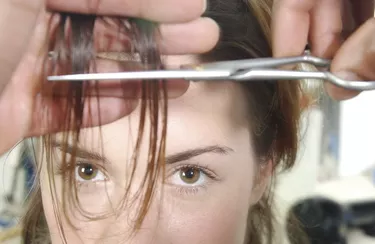
Training to be a cosmetologist prepares you for a world of career opportunities. With federal education tax benefits, you also are eligible to receive a tax break on both the tuition and any interest you pay on a student loan to finance your new career. You may qualify for the Lifetime Learning Credit or the Tuition and Fees Deduction.
Lifetime Learning Credit
Video of the Day
The Lifetime Learning Credit allows a credit against tax owed of up to $2,000 per tax return for educational expenses paid by you for your own tuition (or that of a spouse or a dependent whom you claim on your tax return). You can take this credit for any education at an eligible institution, whether or not you are pursuing a degree or other credential. Cosmetology school supplies are covered because most schools require a lump-sum payment for these items be made directly to the school. Additional requirements for the Lifetime Learning Credit are that your modified adjusted gross income must be under $60,000 ($120,000 for married filing jointly), you may not be claimed by someone else as a dependent, and you and your spouse must be United States residents or resident aliens for tax purposes. Once you've started working, you can use the credit for required continuing education. You can take the credit for an unlimited number of years, as long as you have educational expenses.
Video of the Day
Tuition and Fees Deduction
The tuition and fees deduction covers tuition and required fees up to $4,000 per return, and there is no limit to the number of years you can claim the deduction. You cannot deduct the cost of transportation or room and board, but you can include the cost of cosmetology supplies if your school requires that you pay them directly as a condition of enrollment. You may take the deduction as long as your modified adjusted gross income is under $80,000 ($160,000 for married filing jointly). You cannot take the benefit if someone else can claim you as a dependent or you are not a U.S. resident. Nonresidents treated as resident aliens for tax purposes can take the deduction.
General Eligibility Requirements
To take either of these tax breaks, you must pay educational expenses to a qualified institution. This includes any educational or vocational institution that is eligible to participate in a financial aid program run by the U.S. Department of Education. Check with your institution before enrolling to be certain it is covered. Most cosmetology schools have specific financial aid information on their website and whether they qualify for Federal Student Aid programs. You may not take either of the deductions if you file married filing separately. You can only take one educational credit per tax year, even if your expenses exceed the maximum. Choose the credit that allows you the largest tax reduction.
Which Education Benefit Is Better?
Since you may only claim one education benefit per student in a tax year, it may be difficult to determine which one will give you the lowest overall tax liability in the event you qualify for both. Many factors come into play, including your total income, other deductions and how many dependents you claim. You should calculate your tax return using first one benefit and then the other to determine the more advantageous situation for you. The tuition and fees deduction is an adjustment of up to $4,000 to your income, not a reduction in the amount of tax you owe. A lower taxable income means you will owe less tax. The Lifetime Learning Credit reduces the amount of tax you owe. It is nonrefundable, which means if you owe less than $2,000, you can only take the credit up to your tax liability.
Which Forms to Use
Your educational institution should send you Form 1098-T Tuition Statement by the end of January following the end of the tax year. Use the information from this form to file your tax return. If you take the Lifetime Learning Credit, use Form 8863 (Education Credits). Fill in your eligible expenses in Part II and carry the amount from Line 23 to Form 1040, Line 49. For the tuition and fees deduction, fill in Form 8917 (Tuition and Fees Deduction) to determine the amount of your deduction. Carry the final deduction from Line 6 to Form 1040, Line 34.
Student Loan Interest Deduction
If you borrowed money to cover tuition and fees for cosmetology school, you get an additional tax break for the interest paid on your student loans. The bank or loan originator should send you a Form 1098-E (Student Loan Interest Statement) in January with the information needed to take the deduction when you file your taxes. You may deduct the interest paid (up to $2,500 in 2011) as an adjustment to income, rather than having to file Schedule A (Itemized Deductions). If your modified adjusted gross income is more than $60,000 ($120,000 for married filing jointly) your deduction may be reduced. Fill in the worksheet included with Form 1040, and transfer the total amount of the deduction to Line 33 of Form 1040.